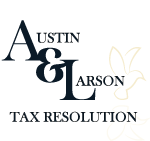A tax levy is the IRS’s legal seizure of your property to satisfy unpaid taxes. To get a tax levy released, you have four main options: (1) pay the full tax debt, (2) set up an IRS payment plan, (3) prove economic hardship, or (4) submit an Offer in Compromise to settle for less than you owe. The IRS must send a Final Notice of Intent to Levy at least 30 days before taking action, giving you time to respond. Tax levies can seize wages, bank accounts, Social Security benefits, retirement accounts, vehicles, and real estate. The fastest release method is full payment, but the IRS will also release levies if they create financial hardship or if releasing them helps you pay your taxes. If you’re facing tax levy issues, Austin & Larson Tax Resolution can help you navigate these complex situations and find the best solution for your circumstances.
Key Facts:
- The IRS has a 10-year statute of limitations to collect tax debts
- You must receive proper notice before a levy is enforced
- Currently Not Collectible (CNC) status can temporarily stop all collection efforts
- Responding within 30 days of the Final Notice is critical to avoiding asset seizure

Understanding A Tax Levy
A tax levy is a legal seizure of property or assets by the IRS to satisfy an outstanding tax debt. Unlike a tax lien, which is a claim against your assets, a levy takes actual possession of your property. This can include wages, bank account funds, Social Security payments, retirement accounts, vehicles, real estate, and even jointly held assets such as business revenue or rental income.
Before enforcing a tax levy, the IRS will generally exhaust other collection efforts. It does not happen without prior notice. Several letters and warnings will precede the action, giving you an opportunity to address the debt before the levy is enforced. For businesses facing these issues, specialized tax assistance for businesses in Brighton, MI can provide crucial support.
Understanding the IRS Timeline for Tax Levies
A tax levy is not immediate. It is typically issued after the following three steps occur:
- The IRS assesses the tax and sends a bill, known as a Notice and Demand for Payment.
- You fail to respond or refuse to pay the balance due.
- The IRS sends a Final Notice of Intent to Levy and Notice of Your Right to a Hearing at least 30 days before enforcing the levy.
This notice can be delivered in person, left at your residence or business, or mailed to your last known address via certified mail. Even if you did not receive the notice due to a change of address, the IRS can still move forward with the levy if proper procedure was followed.
In cases involving a state tax refund, a Notice of Levy on a State Tax Refund may be issued after the IRS applies your refund to your tax debt. The Michigan Department of Treasury also has similar procedures for state tax levies.
Property and Assets Subject to a Tax Levy
The IRS has wide latitude when enforcing a tax levy. The assets subject to seizure include:
- Wages and salary
- Bank accounts
- Social Security benefits
- Retirement income
- Rental property revenue
- Accounts receivable
- Vehicles, homes, and other personal property
The IRS may even seize property in which you have a partial interest. For example, if you co-own a business or bank account, your portion may be subject to levy. Understanding IRS tax levies and wage garnishments in Brighton, MI is crucial for protecting your assets.

Ways to Stop or Avoid a Tax Levy
There are several methods available to stop a tax levy or prevent one from being issued in the first place. Each option depends on your financial circumstances and how quickly you take action. Here are four primary ways to address a tax levy:
1. Request a Payment Plan
A payment plan, or installment agreement, allows you to pay your tax debt in manageable monthly payments. Depending on how much you owe and how soon you can pay it off, the IRS may approve a short-term plan (typically 180 days or fewer) or a long-term plan that extends over several months or years. Learn more about IRS installment agreements in Brighton, MI to see if this option is right for you.
Once the payment plan is approved, the IRS may release the levy. This allows you to regain access to your assets and income while remaining compliant with the repayment schedule. The U.S. Department of Treasury oversees these collection procedures and ensures they’re followed properly.
2. Demonstrate Economic Hardship
If a tax levy leaves you unable to meet essential living expenses, you may qualify for relief under the IRS’s economic hardship rules. Economic hardship occurs when the levy creates an unreasonable burden, such as leaving you without enough income to pay for housing, food, utilities, or medical care.
To qualify, you must provide documentation showing your income, expenses, and financial obligations. If approved, the IRS will release the levy and stop further enforcement while your hardship status is active. The Consumer Financial Protection Bureau offers resources to help document financial hardship situations.
3. Request Currently Not Collectible Status
If you are unable to pay due to financial hardship, you can request currently not collectible (CNC) status. This designation means the IRS has temporarily suspended collection efforts because forcing payment would create undue hardship. Our experts in IRS non-collectable status in Brighton, MI can help you determine if you qualify.
While CNC status doesn’t eliminate your tax debt, it provides immediate relief from levies, garnishments, and other collection actions. Interest and penalties may continue to accrue, and the IRS may periodically review your financial condition to determine if you’re able to begin paying in the future.
4. Submit an Offer in Compromise
An Offer in Compromise (OIC) allows you to settle your tax debt for less than the full amount owed. The IRS considers your income, expenses, asset equity, and ability to pay when reviewing the offer. Get professional help with an Offer in Compromise in Brighton, MI to maximize your chances of acceptance.
Submitting an OIC does not guarantee acceptance, but if your offer is under consideration, the IRS may suspend collection activity, including the release of any active levy. This gives you breathing room while your financial situation is evaluated. The U.S. Tax Court can review disputed OIC decisions if necessary.

How to Get a Tax Levy Released
The fastest way to have a tax levy released is by paying the full tax debt. However, this is not always a feasible option. Fortunately, the IRS can release a levy without requiring full payment if certain conditions are met. Common scenarios that may lead to a levy release include:
- The collection statute of limitations expired before the levy was issued.
- Releasing the levy will make it easier for you to pay the taxes.
- The levy creates a financial hardship, meaning it prevents you from covering basic living expenses.
In these situations, you may be able to negotiate a resolution with the IRS that halts further seizure activity. However, compliance with the terms of any agreement is essential. If you default on the terms, the levy may be reissued. Working with a local tax attorney in Brighton, MI can significantly improve your chances of a successful resolution.
The 10-Year Collection Rule and Tax Levy Expiration
The IRS generally has 10 years from the date of assessment to collect unpaid taxes. This is known as the Collection Statute Expiration Date (CSED). Once the 10-year period expires, the IRS can no longer legally enforce collection, including issuing a tax levy, unless certain events have extended the statute of limitations.
Examples of actions that pause or extend the collection window include:
- Filing for bankruptcy
- Submitting an Offer in Compromise
- Requesting a Collection Due Process hearing
- Leaving the country for an extended period
Knowing your CSED is essential if you’re nearing the end of the collection period. You may be able to avoid a tax levy altogether by monitoring the timeline and using available legal protections. In extreme cases, you may need to explore options to file for bankruptcy for IRS tax debt forgiveness in Brighton, MI.

The Importance of Responding Early
Timing is critical when dealing with a tax levy. Ignoring notices or failing to respond to IRS communications only increases the risk of enforcement. Responding promptly allows you to explore resolution options before assets are seized. Whether you need tax assistance for individuals in Brighton, MI or help for your business, early intervention is key.
It’s also important to keep your contact information up to date. Many taxpayers miss critical notices because they’ve moved or changed addresses without notifying the IRS. By staying informed, you gain time and flexibility to address the situation proactively. The Social Security Administration can help ensure your information is current if you receive benefits that might be levied.
Preventing Future Tax Levies
Once a levy is released or avoided, the goal should be to prevent future issues. Some steps to help ensure ongoing compliance include:
- Filing all future tax returns on time
- Paying current taxes as they become due
- Staying in compliance with any IRS payment plans
- Keeping accurate financial records
- Monitoring IRS correspondence closely
By practicing good tax habits, you reduce the risk of future enforcement actions and protect your financial stability. Professional tax preparation in Brighton, MI can help ensure accuracy and timeliness. Additionally, maintaining proper tax compliance services in Brighton, MI is essential for ongoing peace of mind.
Self-employed individuals face unique challenges and should consider specialized tax assistance for self-employed in Brighton, MI to stay compliant. The National Association of Enrolled Agents provides additional resources for tax professionals who can help. Similarly, the American Institute of CPAs offers guidance on best practices for tax compliance.
If you face an audit during this process, having proper tax audit representation in Brighton, MI can make a significant difference. For those dealing with state tax issues, a Michigan state tax attorney can provide specialized assistance. The Financial Industry Regulatory Authority also provides investor education resources that can help with financial planning.
For businesses, the Small Business Administration offers resources and guidance on tax compliance and financial management. If you’re in the Ann Arbor area, a tax lawyer in Ann Arbor, MI can provide localized support for your tax resolution needs.
Conclusion
Facing a tax levy can be overwhelming, but you do have options to regain control. Whether you pay the debt in full, set up a payment plan, claim economic hardship, or submit an Offer in Compromise, swift action can prevent asset seizure or stop an active levy. Understanding the IRS process, including the importance of the 30-day notice period and the 10-year collection window, empowers you to act strategically. Financial hardship, if well-documented, can halt enforcement efforts through Currently Not Collectible status or even result in a levy release. Once the levy is lifted, maintaining compliance is essential to avoid future issues. That means staying current with tax filings, payments, and responding promptly to all IRS communications. Knowing your rights and acting quickly are the keys to navigating and resolving a tax levy situation with minimal financial disruption.
FAQs
What triggers a tax levy from the IRS?
A levy is triggered after you fail to pay taxes or respond to multiple IRS notices, including the Final Notice of Intent to Levy.
How do I know if the IRS has sent a Final Notice?
The IRS must send the notice by certified mail, in person, or leave it at your last known address at least 30 days before enforcement.
Can the IRS take money from joint accounts or shared assets?
Yes. The IRS can levy assets in which you have a partial interest, including joint bank accounts and business revenue.
What qualifies as economic hardship for levy release?
If the levy prevents you from covering essential expenses like food, housing, or medical care, you may qualify for hardship relief.
Will a payment plan automatically stop a tax levy?
A payment plan doesn’t instantly stop a levy, but once approved, the IRS may release the levy and suspend further collection.


Recent Comments